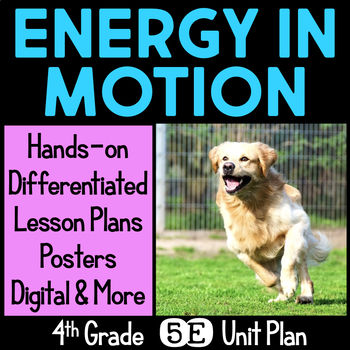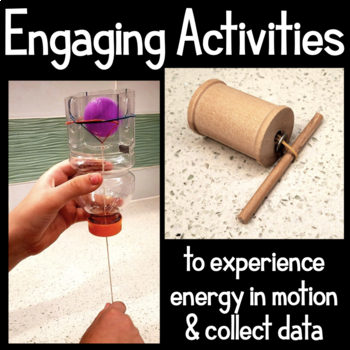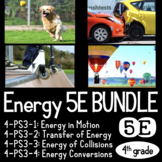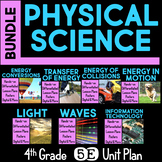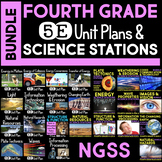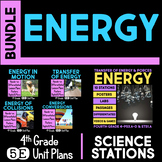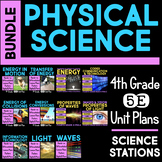Energy in Motion 5E NGSS Science Unit Plan - Fourth Grade 4-PS3-1
- PDF
- Google Apps™
- Easel Activity
- Easel Assessment

What educators are saying
Also included in
- Welcome to my Energy 5E UNIT BUNDLE for Fourth Grade! This is a BUNDLE of all of the 5E ENERGY Units for fourth grade. 5E Units include: Energy in Motion, Transfer of Energy, Energy of Collisions, and Energy Conversions. These units are designed to provide your students with a comprehensive understaPrice $29.00Original Price $39.60Save $10.60
- This is a BUNDLE of all of the Physical Science 5E Units for fourth grade. 5E Units include: Energy in Motion, Transfer of Energy, Energy of Collisions, and Energy Conversions, Light, Waves, and Information TechnologyENERGY IN MOTIONThe Energy in Motion 5E Science Unit Plan is an inquiry-based unitPrice $52.00Original Price $69.30Save $17.30
- This is a BUNDLE of all the 5E Unit Plans for Fourth Grade. The 5E Instructional Model walks students through the five components of inquiry-based learning. Each unit includes multiple lessons for each of the 5Es and provides a structure for your science instruction.There are 14 5E Units for FourthPrice $105.00Original Price $148.35Save $43.35
- This is a BUNDLE of all the 5E Unit Plans AND Science Stations for Fourth Grade. There are 88 Fourth Grade Science Stations in 11 Units and 14 5E Model Instructional Units.This MEGA BUNDLE includes the following 5e Model units:Physical ScienceEnergy in MotionTransfer of EnergyEnergy of CollisionsEnePrice $240.00Original Price $420.79Save $180.79
- This is a BUNDLE of all of the 5E ENERGY Units for fourth grade AND the Science Stations for Energy. Topics include: Energy in Motion, Transfer of Energy, Energy of Collisions, and Energy Conversions. 5E ENERGY IN MOTION5E TRANSFER OF ENERGY5E ENERGY OF COLLISIONS5E ENERGY CONVERSIONSEnergy SciencePrice $42.00Original Price $69.25Save $27.25
- This is a BUNDLE of all of the Physical Science 5E Units for fourth grade AND the Science Station Units for Physical Science. Units in this Physical Science BUNDLE include5E Energy in Motion5E Transfer of Energy5E Energy of Collisions5E Energy Conversions5E Information Technology5E Light5E WavesSciePrice $89.00Original Price $177.45Save $88.45
Description
Inquiry-based and packed with hands-on activities, the Energy in Motion 5E NGSS Science Unit Plan is perfect for introducing your fourth grade class to the concepts of energy and motion! By the end of the unit, students will have a thorough understanding of how energy affects motion, thanks to engaging lessons and activities like observing the motion of different objects, analyzing data to explore the relationship between energy and motion, and more.
KEY CONCEPTS IN THIS 5E UNIT ABOUT ENERGY IN MOTION INCLUDE
- Relationship of energy and speed
- Relationship of energy and motion
- Motion of different objects and the energy of that motion
Included in this Energy in Motion Science Resource
► Three activities for each of the 5E's (Engage, Explore, Explain, Extend, and Evaluate)
► Teacher Notes that provide an overview of the resource and explanation of the NGSS standard for Energy in Motion 4-PS3-1
► Common Misconceptions about Energy in Motion
► Teaching Timeline available with four different options, including a correlation with the Fourth Grade Science Stations
► Vocabulary Cards to reinforce key terms throughout the unit. These are similar vocabulary cards available in the Fourth Grade Science Stations
► Big Idea Posters that illustrate the main concepts students will learn
► Differentiated Science Reading Passages to Explore and Explain the topic
► Science labs, experiments and hands-on activities to Explore, Explain, and Extend the learning
► Formative Assessments that Evaluate student learning in three different ways
► Exit Tickets in three formats: short answer, fill-in-the-blank, and multiple choice
OPTIONAL FREE BONUS UPGRADE TO DIGITAL COMPONENTS:
► Google Slides Teacher Presentation Lesson Slide Deck that supports the student resources
► Google Slides Student Resources for a paperless option
► Google Form Exit Cards to monitor student understanding
► Easel by TpT Activity for the Student Sheets
► Easel by TpT Assessment for the Exit Cards
What is the 5E Instructional Model?
The 5E Model is student-led, with the teacher acting mainly as the facilitator. Through open-ended questions, real-life experiences, guided investigations, and research, the students gain a deep understanding of the scientific topics that are covered in the lessons. Each stage of the model serves as a foundation to the next, creating a coherent model that frames lessons, activities, and units.
Find out more about the 5E Unit Plans in this blog post.
___________________________________________________________________________
Objectives and Timeline for Each Section of the 5E Energy in Motion Unit
Engage
Objectives:
- Students will access their prior knowledge about how energy and speed are related.
- Student interest in energy and speed will be elicited.
- The teacher will be able to identify student misconceptions about energy and speed.
Parts and Duration:
- Part 1 (What Is This?): 10 minutes
- Part 2 (My Experiences): 15 minutes
- Part 3 (Introducing): 15 minutes
Explore
Objectives:
- Students will work together to investigate energy and motion. They will do this by observing the motion of different objects, drawing inferences about the energy in those motions.
- Students will gather general information about energy and motion.
- Students will begin to think about how energy and motion are related.
- Students will analyze and interpret data to provide evidence that energy and motion are related.
Parts and Duration:
- Part 1 (Check It Out): 20 minutes
- Part 2 (Read This): 15 minutes
- Part 3 (You Try It): 15 minutes
Explain
Objectives:
- Students will work collaboratively to observe and discover how energy and motion are related.
- Students will listen to the teacher’s explanation about energy of motion.
- Students will use the new information to revise their explanations about energy and motion.
Parts and Duration:
- Part 1 (What Does It Mean?): 10 minutes
- Part 2 (What is the Energy of Motion?): 20 minutes
- Part 3 (Putting It All Together): 20 minutes
Extend
Objectives:
- Students will apply what they have learned about the energy of motion to a new situation.
- Students will deepen their understanding of energy and motion, gaining a more generalized knowledge of these specific scientific concepts.
- The teacher will resolve all persisting student misconceptions about energy and motion.
Parts and Duration:
- Part 1 (Where Is the Energy?): 15 minutes
- Part 2 (Show What You Know): 20 minutes
- Part 3 (Have Fun With It): 20 minutes
Evaluate
Objectives:
- Students will evaluate their own understanding of the energy of motion.
- Students will be able to demonstrate knowledge of the concepts and vocabulary.
- The teacher will encourage students to ask questions that could lead to future investigations.
Parts and Duration:
- Part 1 (What I Know): 15 minutes
- Part 2 (Showing Energy): 30 minutes
- Part 3 (Going Forward): 15 minutes
These 5E Unit Plans correlate with the Fourth Grade Science Stations.
___________________________________________________________________________
CLICK HERE TO FOLLOW ME ON TPT | CLICK HERE TO CHOOSE A FREE RESOURCE
TERMS OF USE
Copyright © What I Have Learned, Jessica Boschen
Permission to copy for single classroom or homeschool family use only.
This product may not be distributed or displayed digitally for public view.
Please purchase additional licenses if you intend to share this product.

